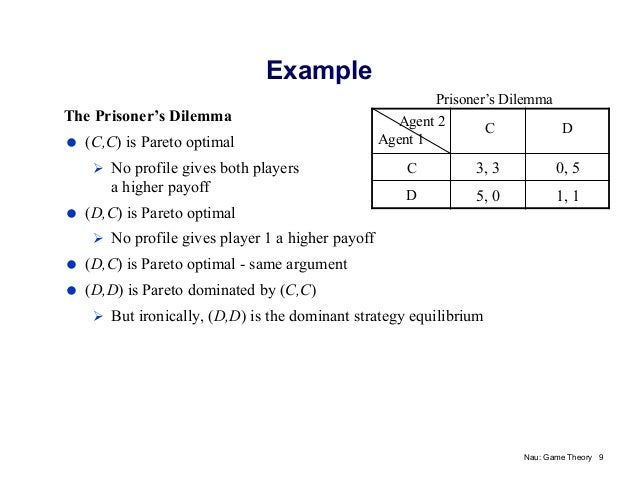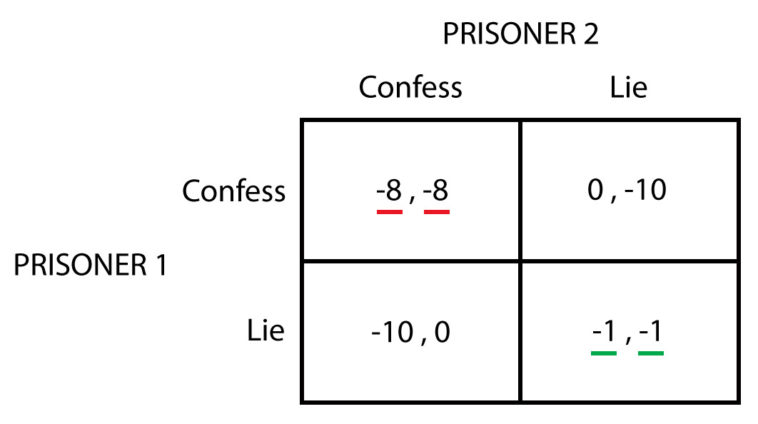Game Theory Optimal Strategy
Well, obviously, throwing one third, one third, one third would be the game theory optimal approach. The problem with that is while you won't lose, you also won't win if you stick to that- unless you get lucky, of course. But that's not an exploitative strategy. Now, what if you find- you notice that your opponent throws rock a lot? Strategy profile sis Pareto optimal, or strictly Pareto efficient, if there’s no strategy s' that Pareto dominates s Every game has at least one Pareto optimal profile Always at least one Pareto optimal profile in which the strategies are pure Nau: Game Theory 9. The strategy corresponding to the Nash equilibrium is an optimal mixed strategy in ∆. Since game ∆ is fair (i.e. Its value is 0 and the sets of optimal strategies for the first and second player are the same), an optimal mixed strategy can be found by the solution of some linear feasibility problem.

In 1912 the German mathematician Ernst Zermelo proved that such games are strictly determined; by making use of all available information, the players can deduce strategies that are optimal, which makes the outcome preordained (strictly determined).
About the CourseThis course is an introduction to game theory and strategic thinking. Ideas such as dominance, backward induction, Nash equilibrium, evolutionary stability, commitment, credibility, asymmetric information, adverse selection, and signaling are discussed and applied to games played in class and to examples drawn from economics, politics, the movies, and elsewhere.
Course StructureThis Yale College course, taught on campus twice per week for 75 minutes, was recorded for Open Yale Courses in Fall 2007.
During the first decade of the 2000s, poker’s popularity soared as the general public watched Chris Moneymaker win the World Series of Poker main event in 2003. The explosion of internet poker that followed made the game more accessible to everyone around the world, regardless of their proximity to a casino.
During those early days of the poker boom, most poker strategy would be considered by today’s standard very basic, and sometimes just completely wrong. As more money flowed into the game and more people were willing to play poker at higher stakes, some players took the opportunity to advance strategy to the next level.
Those players developed what is commonly referred to now as a game theory optimal (GTO) strategy and it’s steadily making its way to the masses. Through his book Modern Poker Theory, released in 2019, poker pro Michael Acevedo tried relaying these advanced theories to the masses in a way that is easily relatable to those who have never heard of the concept.
is a former mathematician and was a part of the team that developed one of the most advanced GTO solvers on the planet. He plays mostly online and in some of the biggest tournaments that online poker has to offer. Card Player sat down with Acevedo to discuss the basics of the strategy lined out in his book.
Steve Schult: Let’s dive into your background. When did you decide to play professionally and how quickly were you moving up in stakes?
Game Theory Competitive Advantage
Michael Acevedo: I quit my job to play professionally in 2013. Back then, I used to play live no-limit hold’em cash games, but due to bad bankroll management, I busted almost all of my bankroll by June 2014. I barely managed to get accepted by an online staking group that offered me coaching and a bankroll to play $5-$10 multi-table tournaments.
I watched over 200 coaching videos in the first three months. After six months, I was already beating $22 tournaments and got the opportunity to have a coaching session with Jon Van Fleet, known online as “Apestyles.” I was lucky and became friends with him. He invited me to his weekly GTO study group with some other world-class players such as Stephen Chidwick, Elio Fox, Dylan Linde and Martin Kozlov.
Then I very quickly moved up in stakes. Soon, I was beating $55 tournaments and started coaching lower stakes players. About one year after starting my online quest, I was beating $109 and $215 buy-ins.
SS: Where are you in your poker career right now? What are your main games and stakes?
MA: For the last year and a half mostly been playing during the big online poker series such as SCOOP (Spring Championship of Online Poker) and WCOOP (World Championship of Online Poker) where I mostly play tournaments ranging from $55 up to $2,100. I have an average buy-in of $360 with the occasional shot to $5,000 and $10,000 championship events. I also go every year to the World Series of Poker where I play live $5-$10 and $10-$20 no-limit hold’em cash games and tournaments ranging from $500 to $5,000, along with a shot at the main event.
I would potentially like to get in the super high rollers and live poker, but I think I would have to start off by putting in a lot more volume than I have so far, start traveling and there are also a lot of bankroll considerations. I’ve never been a grinder and I also enjoy coaching and creating poker content. So, for now, I’m very happy with my current stakes and I’m not sure about giving up my lifestyle and coaching to pursue the glory.
SS: Your book seems to focus on GTO strategy. For someone who might not have heard of this before, what are the basics of GTO strategy and how does it differ from ‘old school’ exploitative strategy?
MA: In the poker world, GTO is used as a synonym of the mathematical concept of Nash Equilibrium. Maybe the easiest way to think about GTO or Game Theory Optimal is in the sense that GTO is a strategy that cannot be beaten. So if all players at the table played GTO, they would break even and the only winner would be the casino due to the rake.
But fortunately for us, no one can play perfect GTO. First of all, because the full solution of the game hasn’t been found yet and might never be found due to its complexity. And second, because it is very tough to always play in such a balanced way. Computers can do it and play every single combo on its range with mathematical precision, but for us humans, that is simply not possible.
Currently, we have the software powerful enough for computers to find really good approximations to GTO in, pretty much, an unlimited number of situations within any given set of parameters. These approximations are good enough to beat even the best human player. Since GTO cannot be beaten, any strategy that deviates from GTO will either make the same amount of money than GTO or lose money to GTO. This is what makes GTO strategies so enticing. Imagine playing a strategy that cannot lose to any other strategy.
Back in the day, most players had serious leaks in their game. Playing an exploitable style without much thought on your own leaks was very profitable. But as the average players become more skilled, the ratio of good players to bad players constantly increases. This leads to smaller edges because vigilant villains are trying to exploit us at the same time as we are trying to exploit them and we no longer have the luxury of being able to ignore our own game.

SS: To expand on that, I’ve heard players talk about how they use a mixture of GTO and exploitative strategy. Basically, they are deviating from GTO when they feel it is optimal. Is this basically what GTO has forced exploitative players to evolve into? How do you approach the game? Strictly from a GTO perspective or do you mix both styles?

MA: As I mentioned before, nobody plays perfect GTO. This opens the door for playing exploitatively when your opponents have leaks in their game. You can deviate from a core balanced strategy to further exploit your opponent’s weakness to increase your profitability, but by doing so, you also open yourself up for exploitation. In general, you should strive to be balanced and as unexploitable as possible when facing very tough opponents, while at the same time being able to max exploit weaker players. The best players in the world are the ones that can do this.
SS:GTO strategy is very math-oriented for obvious reasons, but are you able to work out those numbers at the table? Are you doing mental math or is it more about doing the work away from the table and having a feel for what is right in the moment?
MA:GTO models aren’t indented to be followed blindly, but instead to help us improve our overall understanding of the game so we can make better, more educated decisions that will translate into higher profits over the long run. This is achieved by putting in the work off the tables.
SS: One of the concepts that you touch on in your book that is starting to become more mainstream is range vs. range equity, as opposed to hand vs. hand equities. You’ll hear the term ‘range advantage’ thrown around a lot now. In-game, when should you be thinking about range vs. range as opposed to hand vs. range?
MA: Both are really important. The key idea is that you must always play your hand in the context of your whole range. I see a lot of players making the mistake of only thinking about one.
SS: You have an entire section of your book dedicated to teaching players how to use different poker software. How important is using this software in becoming a better player? How high can you go in stakes before you have to start messing around with solvers?
MA: That’s a tricky question. Most of the youngest top players in the world use GTO solvers or the data derived from them in one way or another. But there are still some old fashion players like Patrik Antonius, who I met recently and had the pleasure to help get up to speed with the latest advancements, who have never messed with solvers themselves. Yet they can still crush the highest and toughest cash games.
SS: In the last decade, poker strategy has taken huge steps forward and the games have gotten much tougher as strategies become more sophisticated and robotic. Do you worry about this at all? As players get closer and closer to solving the game, do you think the game will stay popular and beatable?
Optimal Strategy Definition
MA: Yes and no. Some variants such as heads-up sit-n’-goes and heads-up cash are almost dead. Other variants like six-max cash games and jackpot sit-n’-goes are dying. Multi-table tournaments will still be beatable for a long time due to their complexity and live poker, on the other hand, will probably never die.
I think we can draw a parallel with chess. It has been many years since computers are better than humans at chess, and even though Grandmasters can memorize the first 20 moves of any known opening, there are still big tournaments happening all over the world. And the people who love chess will keep on playing it for as long as they enjoy it.
Game Theory Pdf
If poker has something on its favor compared to chess, it’s the excitement and the thrill of making a big hand, running a sick bluff, or winning a lot of money or a prestigious title. And that cannot be taken away no matter how tough the games get and probably the most important thing about poker is that on any given day anyone can win. Amateurs can take on world champions and have a really cool story to tell for the rest of their lives.